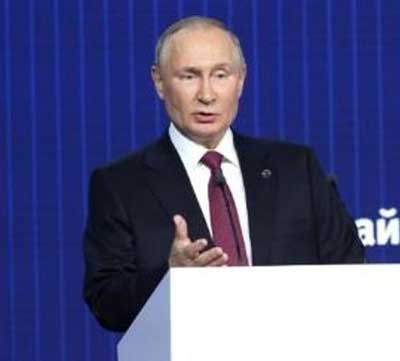Date: 23/02/2023
Relevance: GS-2: Effect of policies and politics of developed and developing countries on India’s interests.
Key Phrases: Strategic Arms Reduction Treaty, Intercontinental Ballistic Missile (ICBM), Submarine-Launched Ballistic Missile (SLBM), nuclear arsenal.
Context:
- Russian President Vladimir Putin declared recently that Moscow was suspending its participation in the New START treaty — the last remaining nuclear arms control pact with the United States.
What is the New START?
- The name START comes from the original “Strategic Arms Reduction Treaty”, known as START-I, which was signed between the US and the erstwhile USSR in 1991, and came into force in 1994.
- START-I, which capped the numbers of nuclear warheads and intercontinental ballistic missiles (ICBMs) that each side could deploy at 6,000 and 1,600 respectively, lapsed in 2009, and was replaced first by the Strategic Offensive Reductions Treaty (SORT, also known as the Treaty of Moscow), and then by the New START treaty.
- The New START, officially, the “Treaty between the United States of America and the Russian Federation on Measures for the Further Reduction and Limitation of Strategic Offensive Arms”, entered into force on February 5, 2011, and placed new verifiable limits on intercontinental-range nuclear weapons.
- The two countries had to meet the treaty’s central limits on strategic offensive arms by February 5, 2018, and to then stay within those limits for the period the treaty remained in force.
- The US and Russia Federation subsequently agreed to extend the treaty through February 4, 2026.

What limits did the New START impose on the two countries?
- The central limits of the treaty that the US and Russia met by February
5, 2018, and have adhered to since then are:
- 700 deployed intercontinental ballistic missiles (ICBMs),
- deployed submarine-launched ballistic missiles (SLBMs), and deployed heavy bombers equipped for nuclear armaments;
- 1,550 nuclear warheads on deployed ICBMs, deployed SLBMs, and deployed heavy bombers equipped for nuclear armaments (each such heavy bomber is counted as one warhead toward this limit);
- 800 deployed and non-deployed ICBM launchers, SLBM launchers, and heavy bombers equipped for nuclear armaments.
Intercontinental Ballistic Missile (ICBM)
- An intercontinental ballistic missile (ICBM) is a ballistic missile with a range greater than 5,500 kilometres (3,400 mi), primarily designed for nuclear weapons delivery (delivering one or more thermonuclear warheads).
- Conventional, chemical, and biological weapons can also be delivered with varying effectiveness, but have never been deployed on ICBMs.
- Most modern designs support Multiple Independently-targetable Reentry Vehicles (MIRVs), allowing a single missile to carry several warheads, each of which can strike a different target.
- Russia, the United States, China, France, India, the United Kingdom, Israel, and North Korea are the only countries known to have operational ICBMs.
Submarine-Launched Ballistic Missile (SLBM)
- A submarine-launched ballistic missile (SLBM) is a ballistic missile capable of being launched from submarines.
- Modern variants usually deliver multiple independently targetable reentry vehicles (MIRVs), each of which carries a nuclear warhead and allows a single launched missile to strike several targets.
- Submarine-launched ballistic missiles operate in a different way from submarine-launched cruise missiles.
- Modern submarine-launched ballistic missiles are closely related to intercontinental ballistic missiles (ICBMs), with ranges of over 5,500 kilometres (3,000 nmi), and in many cases SLBMs and ICBMs may be part of the same family of weapons.
How is Compliance with the Treaty Ensured?
- Detailed procedures for the implementation and verification of the central limits, and all treaty obligations, are part of the treaty terms.
- These procedures govern the conversion and elimination of strategic offensive arms, the establishment and operation of a database of treaty-required information, transparency measures, a commitment not to interfere with national technical means of verification, the exchange of telemetric information, the conduct of on-site inspection activities, and the operation of the Bilateral Consultative Commission (BCC).
- The treaty provides for 18 on-site inspections per year for US and Russian inspection teams.
- Type One inspection focus on sites with deployed and non-deployed strategic systems (up to 10 per year), and Type Two inspections focus on sites with only non-deployed strategic systems (up to 8 per year).
- Since the New START Treaty’s entry into force, as of February 1, 2023, the two parties have conducted 328 on-site inspections, exchanged 25,311 notifications, held 19 meetings of the Bilateral Consultative Commission, and held 42 biannual data exchanges on strategic offensive arms subject to the treaty.
What is the Latest Situation on Compliance?
- The State Department told Congress in January this year that Russia was not complying with the New START, only remaining nuclear arms control treaty between the two countries, jeopardizing a source of stability in their relationship.
- Russia’s refusal to facilitate inspection activities prevents the United States from exercising important rights under the treaty and threatens the viability of U.S.-Russian nuclear arms control.
- Russia has also failed to comply with the New START treaty obligation to convene a session of the bilateral consultative commission in accordance with the treaty-mandated timeline.
Source: The Indian Express
Mains Question:
Q. What is the New START? Discuss the impact of Moscow suspending its participation in the New START treaty. (250 words).






















